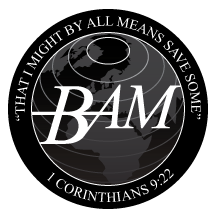Why a Bible School
The aim of the BAM Bible School is give a framework of knowledge on which to build further more detailed study. As the store of teaching material builds, some more detailed study material will be made available but we will always start with the ‘outline’ approach. The purpose is to help “equip the saints (Christians) for the work of ministry”. BAM is a Christian trust which is not connected to any specific denomination. It will not then champion any specific form of church governance but will seek to show through its Biblical studies the principles found in the Scriptures. Looking at Church History may help explain and expand on how different denominations have implemented those principles. BAM contributors will be primarily from the Evangelical approach, holding a high regard for the accuracy and authority of Scripture, both Old and New Testaments. In considering the texts the emphasis will be on what they contain, in order to increase the knowledge of them with the aim of seeing how they work to show us more of God’s saving plan. We will not spend much time (if any) on the interesting, but secondary issues to our main purpose, on discussions relating to Authorship and Date of writing. We will concentrate on the CONTENT not the PROCESS.
Study material which is a combination of new material and existing BAM publications will be made available through the website. We are aware that not everyone has easy access to the internet or the facility to ‘down-load’ or print so it will be possible to ask for material to be posted to you. This will be done via a Bible School Contact page.
Study Material
Principles of Study
Throughout studying the Biblical material we will make reference to Chapters and Verses. These of course are a useful but much later addition. It is vital that verses are understood in the context in which they are found. As a principle of study therefore it is best that the book of the Bible you have chosen to study is read right through first. On the larger books this may be more of a challenge but at least read large sections, ignoring the chapters and verses, and when you return to the text ‘overlap’ your reading. By that I mean start with the last piece of the text you have already read both as a reminder and to help set the context of the new material you are going to read. On a second reading you can make notes of any questions that arise and thoughts that you want to study further.
Register Your Interest
The first modules are now available. You can register your interest HERE: Registration Form
